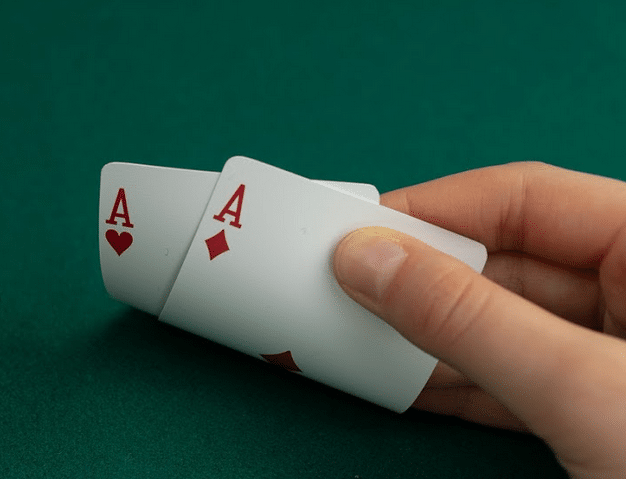In our lesson on the three main betting variations of poker, we used an example where a player in a no-limit game could bet far more than anyone else at the table, provided the player had such an amount. Poker is always played at table stakes, and this means you can only wager the amount of money you have in front of you when the hand begins. It is quite common for a player to run out of money during a hand. If you have more money than another player, it doesn't mean you can bet them out of the pot because they can't afford to call your bet. Otherwise the poker player with the most money would always win if he bet all his chips, and it wouldn't be a very enjoyable game.
All-in Bets
When a player puts all his chips into the pot he is said to be 'all-in'. The important thing to know is that a player can never be bet out of a pot because he always has the option to call for all of his chips. For example, a player with $50 goes all-in, and everyone folds apart from a player who only has $30 left:

This is an important step in becoming an effective Texas Hold'em player. The hand odds will need to be compared to the pot odds to determine whether to stay in the game. To find hand odds, follow this procedure. Express your hand percentage as a whole number. For example, 24 percent becomes 24. Divide 100 by this number. All-in Poker Rules: Rule #1 – Table Stakes – The table stakes rule says that a player can't be forced to wager more than he has brought to the table. In the past, it may have been possible for richer players to bully poorer players by betting amounts so large that no-one would be able to call, even if they wanted to.
- Betting in Texas Hold'em (A variant of Poker) has a definite structure and flow to it. The complexity of the game adds lots of depth and strategy, making it the popular game it is today. As it is a game of probability, poker players usually use mathematics to estimate their chances of success in a hand and place their bets accordingly.
- Texas hold 'em (also known as Texas holdem, hold 'em, and holdem) is one of the most popular variants of the card game of poker. Two cards, known as hole cards, are dealt face down to each player, and then five community cards are dealt face up in three stages.
Figure 1
This player cannot match the $50 bet, but he can also go all-in for his last $30. When nobody else is involved, the first player would get back the unmatched $20 bet (i.e. his bet is $30 rather than $50). This is shown in figure 2, below:
Figure 2
In this example the shorter-stack wins the pot, but the surplus $20 is returned to player 5.
The whole point of this is that players can take back any extra money when another player is all-in for less, when nobody else has called. The same applies to an extreme no limit example, where a player might bet $10,000 in a $1/$2 game. Here's an example where it's folded around to the big blind, who has $10 remaining in his stack.
Figure 3
He has $12 in total and clearly can't match the $10,000 – but he can go all-in. If he does then the player with $10,000, would take back $9,988. No more betting would take place, as there isn't anything left to wager. After the flop, turn and river, the player with the best hand would win the $25 pot ($12 from each plus the small blinds $1).
Side Pots
It can be a little more complicated when there's more than two players involved in a hand. This is when a side pot is created for the other players, and any further bets cannot be won by the all-in player. The all-in player is eligible for the main pot only.
Take a look at figure 4, below, which shows three players remaining in a hand. Two players have $50 each, and another has just $10 remaining. In this example the pot already contains $40 from the previous betting rounds. Player 5 makes a bet of $20:
Figure 4


This is an important step in becoming an effective Texas Hold'em player. The hand odds will need to be compared to the pot odds to determine whether to stay in the game. To find hand odds, follow this procedure. Express your hand percentage as a whole number. For example, 24 percent becomes 24. Divide 100 by this number. All-in Poker Rules: Rule #1 – Table Stakes – The table stakes rule says that a player can't be forced to wager more than he has brought to the table. In the past, it may have been possible for richer players to bully poorer players by betting amounts so large that no-one would be able to call, even if they wanted to.
- Betting in Texas Hold'em (A variant of Poker) has a definite structure and flow to it. The complexity of the game adds lots of depth and strategy, making it the popular game it is today. As it is a game of probability, poker players usually use mathematics to estimate their chances of success in a hand and place their bets accordingly.
- Texas hold 'em (also known as Texas holdem, hold 'em, and holdem) is one of the most popular variants of the card game of poker. Two cards, known as hole cards, are dealt face down to each player, and then five community cards are dealt face up in three stages.
Figure 1
This player cannot match the $50 bet, but he can also go all-in for his last $30. When nobody else is involved, the first player would get back the unmatched $20 bet (i.e. his bet is $30 rather than $50). This is shown in figure 2, below:
Figure 2
In this example the shorter-stack wins the pot, but the surplus $20 is returned to player 5.
The whole point of this is that players can take back any extra money when another player is all-in for less, when nobody else has called. The same applies to an extreme no limit example, where a player might bet $10,000 in a $1/$2 game. Here's an example where it's folded around to the big blind, who has $10 remaining in his stack.
Figure 3
He has $12 in total and clearly can't match the $10,000 – but he can go all-in. If he does then the player with $10,000, would take back $9,988. No more betting would take place, as there isn't anything left to wager. After the flop, turn and river, the player with the best hand would win the $25 pot ($12 from each plus the small blinds $1).
Side Pots
It can be a little more complicated when there's more than two players involved in a hand. This is when a side pot is created for the other players, and any further bets cannot be won by the all-in player. The all-in player is eligible for the main pot only.
Take a look at figure 4, below, which shows three players remaining in a hand. Two players have $50 each, and another has just $10 remaining. In this example the pot already contains $40 from the previous betting rounds. Player 5 makes a bet of $20:
Figure 4
Player 6 only has $10 but he can call for his last $10 (and would therefore be 'all in') or fold. If player 6 decides to go all-in for his last $10, then the last active player (player 7), who has $50, can call, but must call for $20, which is the original bet, or he can raise. If he calls then a side pot is created, as is shown in figure 5:
Figure 5
The main pot now contains $70, which is made up of the existing $40 in the pot, plus $10 x 3. Player 6 is 'all in' and can only win this main pot. A side pot containing the extra $20 is created, and can only be won by the players who contributed to this side pot (players 5 and 7). The next card will be dealt and further betting will take place. Any further bets are added to this side pot, and not the main pot. Players 5 and 7, who contributed to the side pot, can win the side pot and the main pot, if their hand beats the 'all in' player. If player 6 has the winning hand after the final betting round, then he will win the $70 pot, but the side pot will be won by either player 5 or player 7.
Conclusion
There has been quite a bit of information in this lesson, which to the uninitiated could be confusing. As soon as you start playing poker you'll quickly become familiar with these betting basics because they occur very frequently. Sometimes there can be lots of different side pots during a hand involving lots of different players – whether it's limit, pot limit, or no limit poker. This is because not everyone has the same amount of chips – and players who have fewer chips than an opponent cannot win more from a player than they contributed themselves. The important thing to remember is that a player can never be bet out of hand because he doesn't have enough to call.
Related Lessons
By Tim Ryerson
Tim is from London, England and has been playing poker since the late 1990's. He is the ‘Editor-in-Chief' at Pokerology.com and is responsible for all the content on the website.
